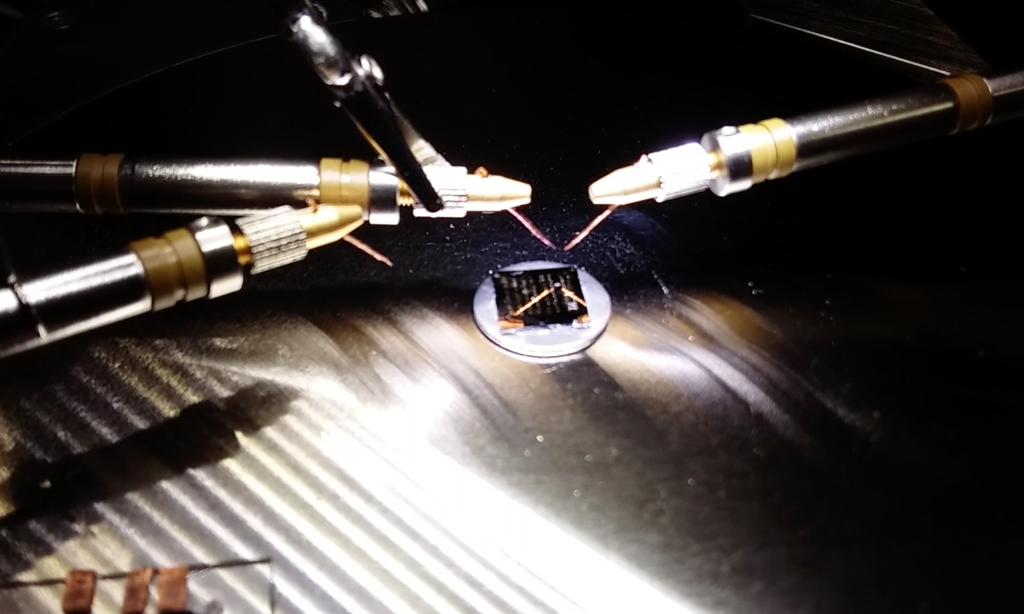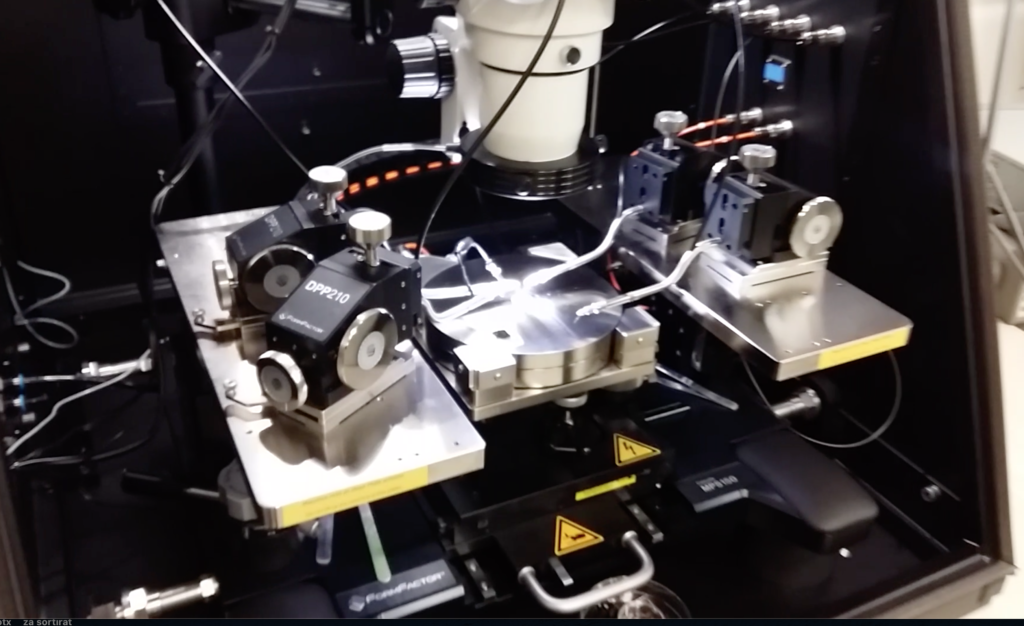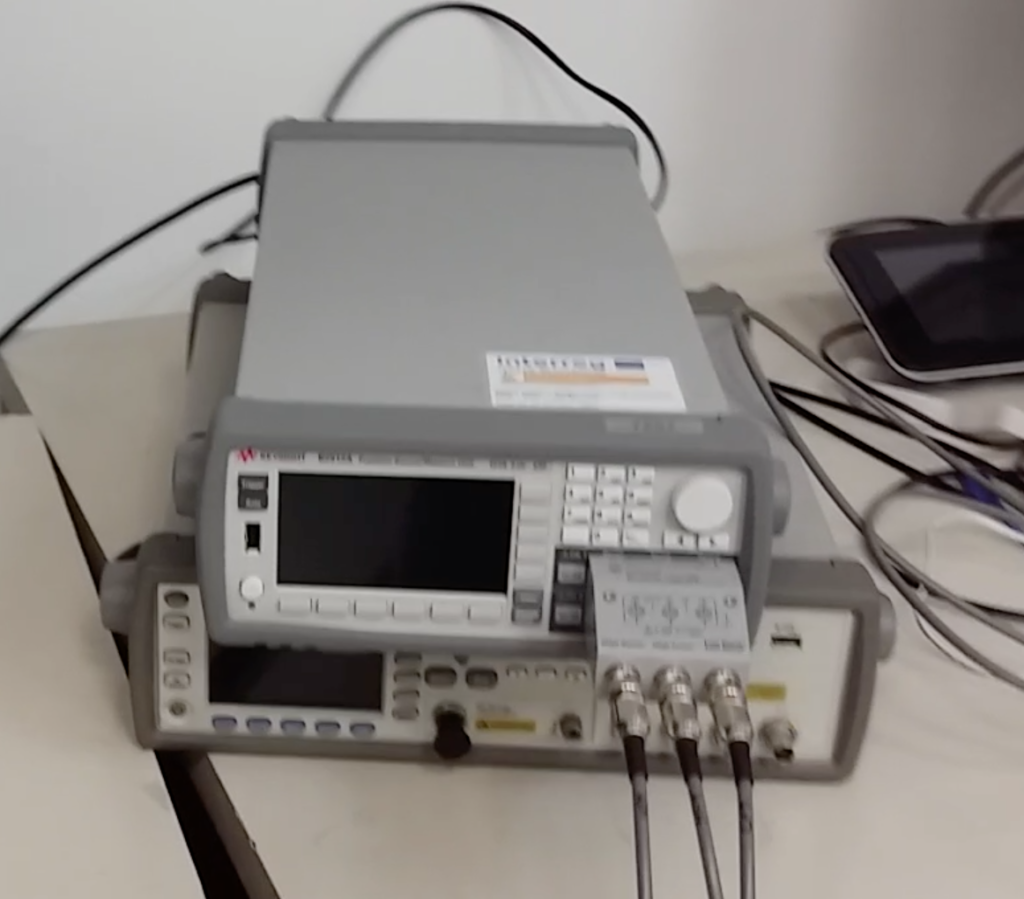Four-Probe Station:
With the four-probe station, we can measure various electrical properties of materials, including:
- Resistance: The four-probe method accurately measures a material’s resistance, eliminating the effects of contact resistance.
- Sheet Resistance: Particularly useful for thin films and layers, providing information on their uniformity and quality.
- Conductivity: This measurement directly relates to resistance and provides information about a material’s ability to conduct electricity.
- Current-Voltage Curves (I-V): Detailed I-V curves can be used to analyze the electronic behavior of devices under different bias conditions.
- Impedance Spectroscopy: This enables the impedance of a material to be measured over a wide frequency range (20 Hz to 2 MHz) and provides information about its dielectric properties, capacitance, and inductance.
The system enables precise (~1µm) positioning of the conductive probes. Equipped with four triaxial probes, it enables the measurement of currents in the sub-pA range. A video camera facilitates manual positioning of the probes with a microscope that allows observation of features down to the micrometer range. The probe holder (chunk) is floating and allows the measurement of the electrical current to/from the probe or the application of a bias voltage to the probe. The probe station is housed in a Faraday darkroom to reduce electromagnetic interference, and an optical workstation (Vision Isostation Newport) is used to minimize mechanical vibrations.
Using the four-probe station, we can measure a wide range of devices and materials, such as:
- Semiconductors: Characterization of wafers, layers, and individual devices such as diodes and transistors to determine their electrical properties.
- Thin Films: Evaluating the uniformity and quality of conductive and resistive layers used in various applications such as sensors and electronic devices.
- Bulk Materials: Evaluation of the resistance and conductivity of materials such as metals, polymers, and ceramics for research and industrial purposes.
- Nanomaterials: Measuring the properties of nanowires, nanotubes, and other nanostructured materials to explore their potential for advanced electronic applications.
- Solar Cells: Investigating the electrical properties of photovoltaic materials and devices to improve their efficiency and performance.
Current-voltage characterization is performed with a Keysight B2912A dual-channel source meter, and impedance spectroscopy in the frequency range between 20 Hz and 2 MHz is performed with the Agilent Precision LCR Meter E4980A.
List of Devices:
- FormFactor Probe Station EPS150Triax: Precision measuring station for accurate electrical measurements.
- Tektronix DSA91304A Oscilloscope: Powerful oscilloscope for signal analysis.
- Keysight B2912A Dual-Channel Source Meter: For precise current-voltage characterization.
- Agilent E4980A Precision LCR Meter: For impedance spectroscopy over a wide frequency range.
- Newport Vision Station: Optical workstation for the reduction of mechanical vibrations.
The four-probe station is available primarily during weekdays from 8 AM to 4 PM, with extended hours available upon request. We also offer training sessions for new users to ensure they can independently operate the equipment and obtain accurate and reliable measurements from their analyses.
For further information, please contact Egon Pavlica (egon.pavlica@ung.si), Laboratory of Organic Matter Physics, University of Nova Gorica.
The system allows precise (~1µm) positioning of conductive probes. Equipped with four triaxial probes allows measurements sub pA currents. Positioning of probes is manual, a video camera with a microscope is used to observe features down to micrometer scale. The sample holder (chunk) is floating, which enables the measurements of the electric current from/to the sample or to apply bias voltage to the sample. Probe station is enclosed in a Faraday dark box to reduce electromagnetic noise. Optical workstation (Vision Isostation Newport) is used to reduce mechanical vibrations.
The current-voltage characterization is performed with a two channel source-meter Keysight B2912A. Impedance spectroscopy in the frequency range between 20Hz-2MHz is performed with Agilent Precision LCR Meter E4980A.
List of equipment:
- FormFactor probe station EPS150Triax
- Oscilloscope Tektronix DSA91304A
- Two channel source-meter Keysight B2912A
- Agilent Precision LCR Meter E4980A
- Newport vision station
Person in charge: dr. Nadiia Pastukhova, +386 5 365 3500, nadiia.pastukhova@ung.si
Equipment location: Laboratory LFOS, University of Nova Gorica, Vipavska c. 11c, Ajdovščina, Slovenia
Equipment accessibility: from Monday to Friday between 8 a.m and 4 p.m., or else in preceding accordance with the person in charge.
Use of the probe station is allowed for trained person!



